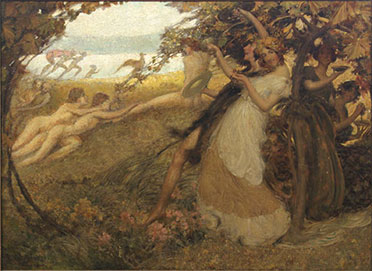
American artist Frank Vincent DuMond was an accomplished illustrator, landscape, muralist, portrait and still life painter.
Born in Rochester, New York in 1865, Frank Vincent DuMond studied at the Art Students League in New York in the 1880s. His career began after that as he found illustration work with New York Daily Graphic, Century, Scribner’s and Harper’s Monthly. In 1888 DuMond attended the Acedémie Julian in Paris where he studied with such notable artists as Benjamin Constant, Gustave Boulanger and Jules-Joseph Lefebvre.
Upon his return to New York, DuMond took up teaching at the Art Students League where he would continue to teach for over 50 years until his death in 1951. Among his most well-known students were Georgia O’Keeffe, Norman Rockwell, Frank Reilly, and John Marin. Around this time DuMond moved to Old Lyme, Connecticut, and became part of the Lyme Art Colony. He relocated to an old Colonial farmhouse and became greatly inspired by the surrounding landscapes, resulting in a drastic change in style from a darker tonalist technique to painting with Impressionist qualities. While living in Lyme, DuMond directed art classes at the prestigious Lyme Summer School of Art, where he instructed students to paint outdoors. He was so committed to teaching, even after moving to Connecticut, that he continued to commute to NY, catching the night ferry from Lyme. One of DuMond’s greatest innovations to painting and instruction was his creation of the Prismatic Palette, a palette laid out with the understanding that yellow, orange and red are predominant in close objects while blue and violet have a stronger influence on distant objects.
Among his most outstanding works are the series of illustrations for Mark Twain’s Personal Recollections of Joan of Arc completed in 1985. During his lifetime, exhibitions of DuMond’s work were displayed at the National Academy of Design, the Corcoran Gallery of Art, the Pennsylvania Academy of the Fine Arts and the Art Institute of Chicago. He was the recipient of numerous medals including gold medals from the Paris Salon and the Mechanics Charitable Exposition of Boston. Today, his work can be found in the collections of the Smithsonian American Art Museum, the Society of Illustrators, the New Britain Museum of American Art, among others.
While his artwork remains impressive to today’s standards, it is his influence as an educator that has made DuMond an important figure to the history of illustration.
